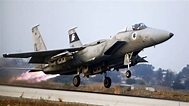
February 18, 2021
By: Jonathan Feldstein
Earlier this week, the Israeli Air Force carried out a three-day exercise simulating a large-scale war against Hezbollah, the terrorist group that controls much of Lebanon, and which reportedly has as many as 150,000 missiles aimed at Israel. Included in the exercise were simulated strikes on some 3,000 Hezbollah targets in a single day. This number of targets in one day is unprecedented, particularly compared to the fact that during the entire 2006 Lebanon War, it’s been reported that Israel reportedly attacked some 5000 targets. The Israeli army undertaking, much less publicizing, this exercise is understood a clear threat to the Lebanese Islamic terror group.
In the simulation, the catalyst that triggered the “conflict” was a Hezbollah surface to air attack against an Israeli aircraft which is something that they tried to do earlier this month, firing anti-aircraft missiles at an Israeli drone.
As unprecedented as this Israeli exercise was, the response from Hezbollah leader Hassan Nasrallah was equally predictable, yet ironic. Hezbollah is a Shiite Islamic terror group that controls most of Lebanon, both militarily as well as its parliament. Last summer’s massive devastating explosion at the Beirut port was linked to Hezbollah arms smuggling. It’s no surprise that at every chance it can, Hezbollah and Nasrallah, as puppets of Iran, will rattle sabers and threaten Israel.
While threatening to bomb Israeli cities as it does with great matter of fact, it was ironic that Israel’s undertaking an exercise in response to a military action by Hezbollah was met with a response from Nasrallah, that the terror group doesn’t want war. As reported on Israeli TV, Nasrallah released a video in which he declared, “We don’t seek a fight with Israel, but if it starts a war, we will fight. Israel’s home front needs to know that if there is a war with Hezbollah, it will see things it has not seen since the establishment of Israel.”
Nasrallah’s own words, “if (Israel) starts a war…with Hezbollah,” underscore that he and his terror group are not protecting Lebanon or the Lebanese people. In fact, by using civilian cover for military installations, Hezbollah threatens the Lebanese people daily. That was never more vivid than in Beirut last year. Because Hezbollah acts on its own and the Lebanese Armed Forces exist only in name, Nasrallah makes no secret that he calls the shots in Lebanon.
The IDF reported that dozens of aircraft participated in the “Galilee Rose” exercise. Adding to the simulation as if it were possibly real, this was not a long-planned exercise and many Israeli reserve troops were called up to active duty at the last minute. An unnamed Israeli officer stated, “In this exercise, we simulated the actions that the entire air force would take, going from peacetime to wartime, in order to deal with these threats, these attacks against our aircraft.”
The IDF stated, “During [the exercise], intense fighting was simulated, along with offensive operations, scenarios involving defending the country’s airspace, command and control operations, precise planning and wide-scale, powerful strikes. In addition, strikes on thousands of targets and the launching of many weapons were practiced to simulate war on the northern front.”
Whenever there will be an actual war with Hezbollah, Israel can and should expect a punishing response. In the month-long 2006 war, over a million Israelis were relocated from the north in order to be out of range from Hezbollah missiles that were neither as numerous nor as long range as the 150,000 pointing toward Israel are today. Accordingly, the “Galilee Rose” exercise simulated Hezbollah’s attacking Israel, including firing of cruise missiles, as well as a massive number of other rockets fired at civilian and military targets in Israel.
For some time, Israel has made it clear that it knows the quantity and nature of weapons that Hezbollah has amassed, and where they are located. Once, a map of southern Lebanon was released, highlighting many of potential future targets, particularly those housed in Lebanese towns and villages. Then, that was considered a warning to Hezbollah, as well as to the residents of the towns which have been hijacked by the terrorist organization.
While the border with Lebanon has been relatively quiet for a few years, what lies beyond the border is alarming. Between concern that Hezbollah may seek revenge for the death of one of its terror leaders last year, or Iran activating Hezbollah as a response to something for which it blames Israel, or a smoke screen for something else, it’s reasonably sure that the Lebanese border will not remain quiet forever. Peace has certainly not broken out.
Israelis see that Hezbollah has grown increasingly brazen in many ways. Not long-ago Israel uncovered and subsequently destroyed a series of cross border attack tunnels into Israel. It’s not projected that Hezbollah wants or is ready to enter a full-blown war with Israel, now at least. Yet there are many internal and external factors that could trigger to act increasingly aggressively. Some can be projected and some, external factors as in Iran pulling Hezbollah’s strings as its proxy, could be sudden. It’s all the more reason why the Israeli exercise was conducted as a surprise, and not something planned for months.
While unlikely to change the terrorist nature of Hezbollah, or their long-term goal to destroy Israel, this week’s simulation clearly signaled what would happen if it again fired upon an Israeli drone, or worse.
Acting as if he were the victim and not the aggressor, Nasrallah noted “If Israel bombs cities in Lebanon, we’ll bomb cities in Israel, and if it bombs villages in Lebanon, we’ll bomb towns in Israel. If the IDF bombs our military targets, we can also attack Israel’s military targets.”
